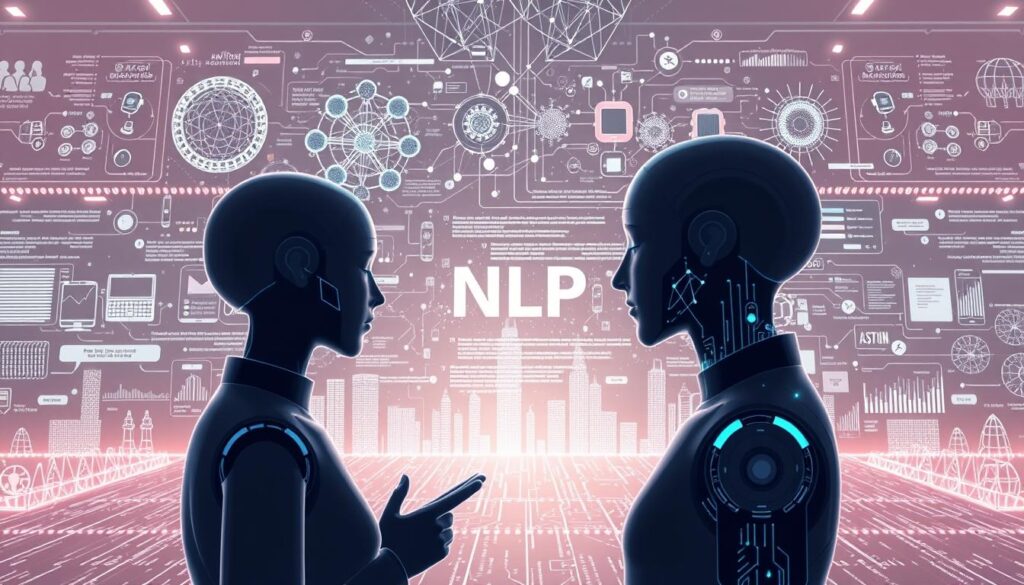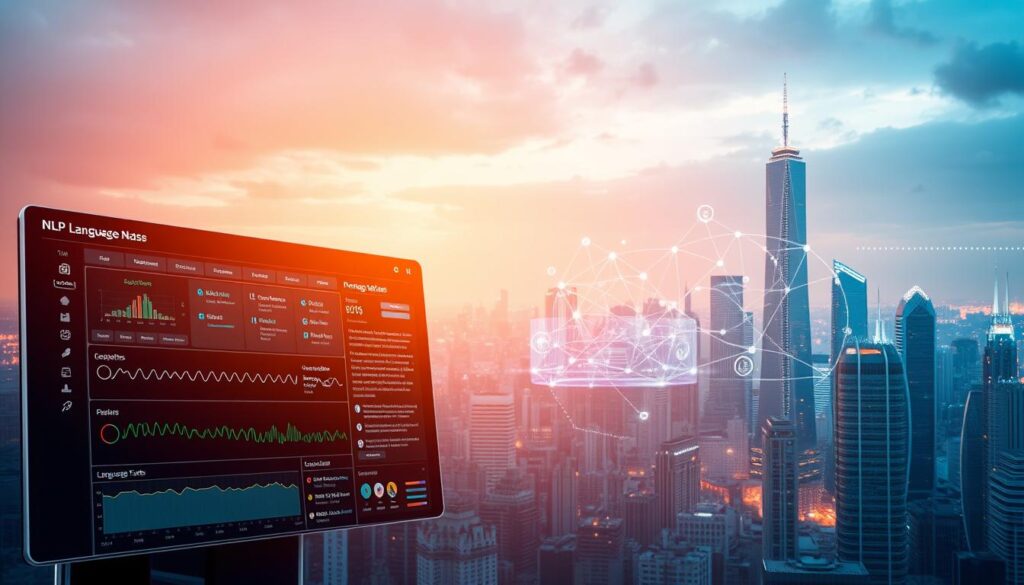Introduction
A huge 90% of the world’s data is unstructured. Natural language processing (NLP) unlocks its value. It’s a part of artificial intelligence (AI) that lets computers talk to us in our own language. This technology is changing the game in many fields, like translating languages and understanding how people feel about things.
Understanding Natural Language Processing (NLP) Fundamentals
Natural Language Processing (NLP) is a part of artificial intelligence. It helps computers talk to humans in their own language. This field is key to NLP techniques that let computers understand and create human language. It’s used in many areas like language modeling, machine translation, and text classification.
The main parts of NLP systems are tokenization, part-of-speech tagging, and named entity recognition. These parts help computers understand and analyze human language. Over time, NLP technology has grown from simple rule-based systems to more advanced machine learning-based ones. This has led to better NLP techniques and NLP applications.
- Language modeling: This involves predicting the next word in a sequence of words.
- Machine translation: This involves translating text from one language to another.
- Text classification: This involves categorizing text into different categories.
These NLP applications have many uses in the real world. They include language translation, sentiment analysis, and text summarization. As NLP technology keeps improving, we’ll see even more exciting NLP techniques and NLP applications in the future.
How NLP is Transforming Modern AI Applications
Natural Language Processing (NLP) is changing Artificial Intelligence (AI) by making machines understand and speak like humans. NLP tools and AI have made big steps in learning and deep learning. This has improved how machines model language, generate text and translate languages.
NLP tools are key in today’s AI, making interfaces more human-like. For instance, Siri and Alexa use NLP to get and answer voice commands. Also, NLP has helped create chatbots and translation software that talk to us more naturally.
Some main uses of NLP in AI are:
- Language modeling and text generation
- Language translation and localization
- Sentiment analysis and opinion mining
- Speech recognition and synthesis

The future of NLP in AI is bright, with more research in deep learning and neural networks. As NLP tools get better, we’ll see even more advanced AI in the future.
Revolutionary NLP Techniques Shaping the Future
Natural language processing (NLP) is changing fast. This is thanks to new NLP software and algorithms. Breakthroughs in transfer learning, attention mechanisms, and graph neural networks have made NLP systems better and faster.
NLP is now used for creating human-like text and dialogue. This is useful for chatbots, language translation, and making content. It also helps in making dialogue systems smarter, so humans can talk to machines more easily.
Some big advantages of these new NLP methods are:
- Improved accuracy and efficiency in NLP systems
- Enhanced natural language generation and dialogue systems
- Increased chances for better human-computer interaction and teamwork

As NLP software and algorithms keep getting better, we’ll see even more cool uses of NLP. From virtual assistants to language translation, the possibilities are endless. These new NLP techniques will help us make a smarter, more connected world.
Real-World Applications and Implementation of NLP
Natural Language Processing (NLP) is used in many fields like business, healthcare, customer service, and education. With NLP training and NLP certification, experts can fully use NLP. This helps them innovate in their areas.
Some main uses of NLP are:
- Text analysis and sentiment analysis in business intelligence
- Medical documentation and clinical decision support in healthcare
- Chatbot solutions and virtual assistants in customer service
- Language learning and tutoring systems in education
NLP can change how businesses and organizations work. For example, NLP chatbots offer 24/7 customer support. NLP language learning systems help students learn faster and better.

The need for NLP experts is rising. It’s key for people to get NLP training and NLP certification. This way, they can apply NLP in real life and help businesses succeed.
Also Read: Investigating the Role of ChatGPT in Transforming Education
Conclusion: The Future Landscape of NLP Technology
Natural language processing (NLP) is changing artificial intelligence. It lets machines understand and talk back to us. New NLP methods, like machine learning, are making big changes in many fields. This includes business, healthcare, and education.
The future of NLP looks very promising. Scientists and developers are working on making these systems even better. They want to make machines understand and create human language more accurately.
These advancements will also improve how we talk to machines. With NLP and new tech like virtual assistants, our interactions will change a lot. We’ll get better at finding and using information.
But, there are big challenges ahead. We need to make sure NLP systems are fair and don’t have biases. It’s important to make sure these systems work for everyone and are ethical.
The future of NLP is full of excitement and new possibilities. It will change our lives and how we talk to machines. By using natural language processing, we can explore new areas in artificial intelligence. This will help us work better together with machines.
FAQ
What is Natural Language Processing (NLP)?
Natural Language Processing (NLP) is a part of artificial intelligence. It helps computers understand and use human language. This makes talking to machines easier and more effective.
How does NLP differ from traditional computing?
NLP is different because it deals with the complex nature of human language. It uses machine learning and deep learning to understand language, unlike traditional computing.
What are the core components of an NLP system?
An NLP system has key parts like tokenizing, tagging parts of speech, and recognizing names. It also includes sentiment analysis and language modeling. These help machines understand and process language well.
How has NLP technology evolved over time?
NLP has changed a lot. It started with simple rules, then moved to machine learning, and now uses deep learning. This has improved how machines understand and use language.
How are machine learning and NLP integrated?
Machine learning is key for NLP. It trains models to understand language. This has led to powerful language models and applications.
What are the key breakthroughs in deep learning for NLP?
Big breakthroughs include BERT and GPT language models. Also, advancements in text generation and translation. These have greatly improved NLP.
How do neural networks contribute to language understanding in NLP?
Neural networks, like RNNs and transformers, have been very important. They help machines understand language better by catching context and relationships.
What are some of the revolutionary NLP techniques shaping the future?
New techniques like transfer learning and attention mechanisms are changing NLP. They’re improving natural language generation and dialogue systems.
What are the educational technology applications of NLP?
NLP is used in language learning, tutoring, and grading essays. It helps analyze student work and gives feedback, improving learning.
What are the applications of NLP in healthcare and medical documentation?
In healthcare, NLP helps with clinical support and record analysis. It improves patient care by extracting important information from medical texts.


Exceptional perspective! Your understanding of digital creativity mirrors what Sprunked Game achieves. The way Sprunked transforms musical expression through its innovative features is truly remarkable.
thank you.
I wanted to thank you for this great read!! I definitely enjoying every little bit of it I have you bookmarked to check out new stuff you post…
thank you, stay tuned
Transformative view! AI Tools List exemplifies the beauty of perfect automation.
thank you